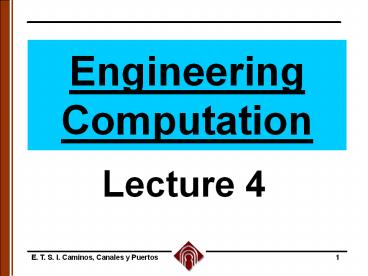Engineering Computation - PowerPoint PPT Presentation
Title: Engineering Computation
1
EngineeringComputation
- Lecture 4
2
Open Methods (Newton-Raphson Method)
Error Analysis for N-R Recall
that Taylor Series gives
where xr ? x ? xi and f(xr) 0
3
Open Methods (Newton-Raphson Method)
Dividing through by f '(xi) yields
OR
Ei1 is proportional to Ei2 gt quadratic rate
of convergence.
4
Open Methods (Newton-Raphson Method)
- Summary of Newton-Raphson Method
- Advantages
- Can be fast
- Disadvantages
- May not converge
- 2. Requires a derivative
5
Open Methods (Secant Method)
Secant Method Approx. f '(x) with backward
FDD Substitute this into the N-R
equation to obtain the iterative expression
6
Open Methods (Secant Method)
Secant Method
f(x)
f(x)
f(xi-1)
f(xi)
f(xi-1)
f(xi)
x
xi1
xi-1
xi1
x
xi-1
xi
xi
xi xi1
7
Open Methods (Secant Method)
1) Requires two initial estimates xi-1 and xi
These do NOT have to bracket root ! 2)
Maintains a strict sequence Repeated
until a. f(xi1) lt k with k small
number b. c. Max. number of iterations is
reached. 3. If xi and xi1 were to bracket the
root, this would be the same as the
False-Position Method. BUT WE DON'T!
8
Open Methods (Fixed point method)
- Fixed point Method
- predict a value of xi1 as a function of xi.
- Convert f(x) 0 to x g(x)
- iteration steps xi1 g(xi )
-
x(new) g(x(old) )
9
Open Methods (Fixed point method)
Example I
10
Open Methods (Fixed point method)
Convergence Does x move closer to real root
(?) Depends on 1. nature of the function 2.
accuracy of the initial estimate Interested
in 1. Will it converge or will it diverge? 2.
How fast will it converge ? (rate of
convergence)
11
Open Methods (Fixed point method)
Convergence of the Fixed point Method Root
satisfies xr g(xr) The Taylor series for
function g is xi1 g(xr) g'(x)(xi - xr) xr
lt x lt xi Subtracting the second equation from the
first yields (xr xi1) g'(x) (xr xi)
or 1. True error for next iteration is smaller
than the true error in the previous iteration if
g'(x) lt 1.0 (it will converge). 2. Because
g'(x) is almost constant, the new error is
directly proportional to the old error (linear
rate of convergence).
12
Open Methods (Fixed point method)
Further Considerations Convergence depends on
how f(x) 0 is converted into x g(x) So .
. . Convergence may be improved by recasting
the problem.
13
Open Methods (Fixed point method)
Convergence Problem For slowly converging
functions
can be small, even though xnew is not close to
root. Remedy Do not completely rely on ea to
ensure that the problem is solved. Check to make
sure f(xnew) lt k .
14
Open Methods (Fixed point method)
15
Open Methods
16
Open Methods
- Why do open methods fail?
- Function may not look linear.
- Remedy recast into a linear form. For example,
Is a poorly constrained problem in that there is
a large, nearly flat zone for which the
derivative is near zero. Recast as i f(i) 0
7,500 i - 1000 1 - (1i)-20
17
Open Methods
- Recast as i f(i) 0 7,500 i - 1000 1 -
(1i)-20 - The recast function, "i f(i) will have the same
roots as f(i) plus an additional root at i 0. - It will not have a large, flat zone, thus
- h(i) i f(i) 7,500 i 1000 1 (1
i)20 - To apply N-R we also need the first derivative
- h'(i) 7,500 - 20,000 (1 i)-21
18
Open Methods
- Cases of Multiple Roots
- Multiple Roots
- f(x) (x 2)2 (x 4)
- x 2 represents two of the
- three roots.
19
Open Methods
- Problems and Approaches
- Cases of Multiple Roots
- 1.Bracketing Methods fail locating x 2.
- Note that f(x?) f(xr) gt 0.
- 2. At x 2, f(x) f '(x) 0.
- Newton-Raphson and Secant methods may experience
problems. - Rate of convergence drops to linear.
- Luckily, f(x) ? 0 faster than f '(x) ? 0
- 3. Other remedies, recasting problem
- Find x such that u(x) 0 where
- Note that u(x) and f(x) have same roots.
20
Summary -- Rates of Convergence
- m 1 linear convergence
- m 2 quadratic convergence
- Method m
- Bisection 1
- False Position 1
- Secant, mult. root 1
- NR, mult. root 1
- Secant, single root 1.618 "super linear"
- NR, single root 2
- Accel. NR, mult. root (f(x)/f'(x)0) 2
21
Three Phase Rootfinding Strategy
- A real rootfinding problem can be viewed
- as having three phases
- 1) Opening moves One needs to find the region
of the parameter space in which desired root can
be found. - Understanding of problem, physical insight, and
common sense are valuable. - 2) Middle Game Use robust algorithm to reduce
initial region of uncertainty. - 3) End game Generate a highly accurate solution
in a few iterations.































